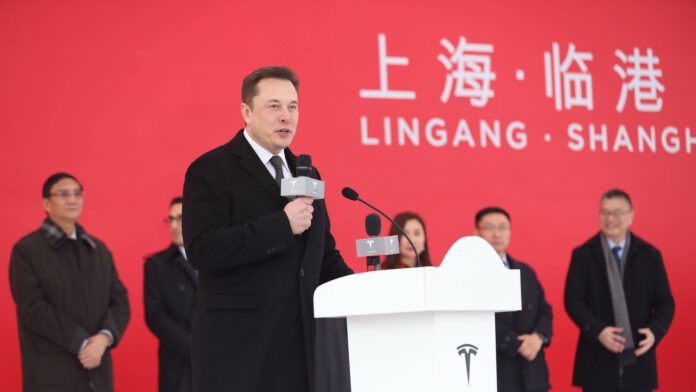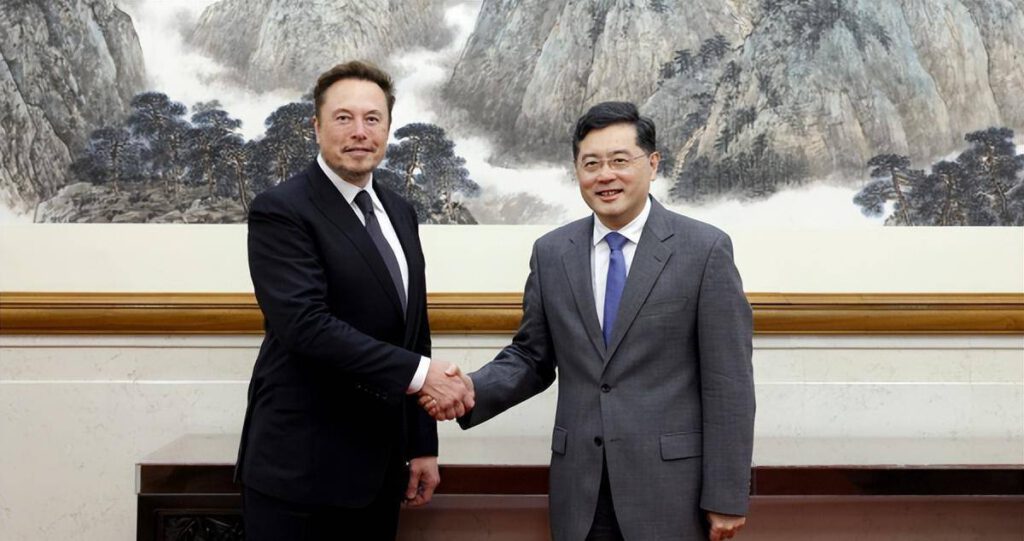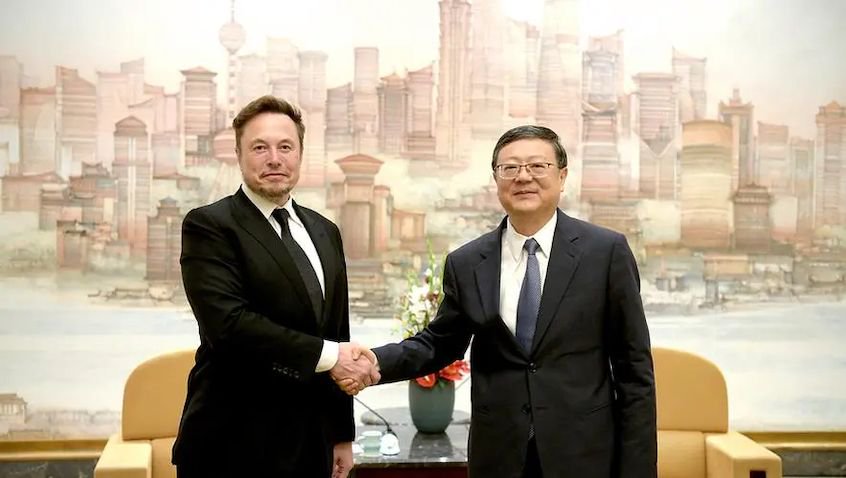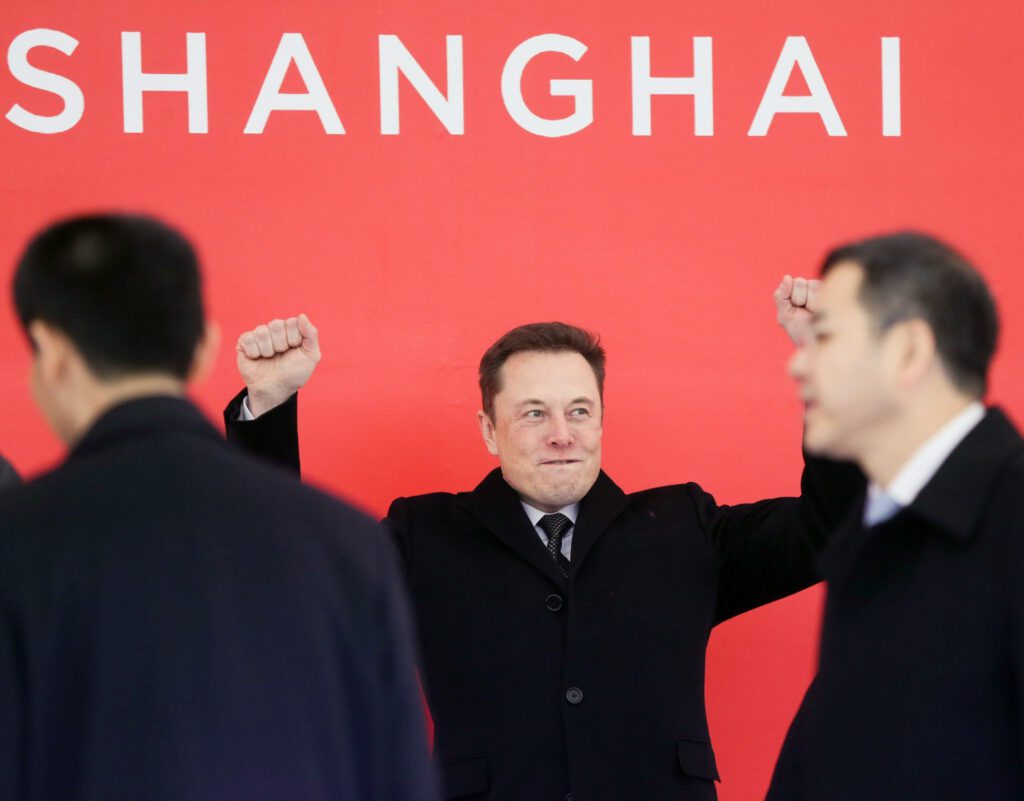
In the afternoon of May 30, Musk landed at Beijing Capital International Airport in a private jet and held a meeting at the Crab Island Resort near the capital airport, at which Tesla’s delivery center completed in September 2021 is located, covering an area of 12,000 square meters, which is Tesla’s largest single delivery center in Asia.
On May 30, China’s State Councilor and Foreign Minister Qin Gang met with Musk in Beijing. According to China’s Ministry of Foreign Affairs, Qin Gang said that China will continue to unswervingly promote a high level of opening up to the outside world and is committed to creating a better market-oriented, rule of law and international business environment for enterprises from all countries, including Tesla Inc.

China’s Foreign Ministry spokesman Mao Ning said at a regular press conference at the Foreign Ministry on May 30 that China has always welcomed business people from various countries, including Mr. Musk, to visit China to better understand China and promote mutually beneficial cooperation. China is happy to see foreign enterprises invest in China, deepen the Chinese market, and share development opportunities.
On May 31, China’s Minister of Industry and Information Technology Jin Zhuanglong met with Musk and exchanged views on the development of new energy vehicles and intelligent networked vehicles. Plus, China’s Minister of Commerce Wang Wentao met with Musk, and the two sides had extensive and in-depth exchanges on topics such as China-US economic and trade cooperation and Tesla’s development in China.

China’s Ministry of Commerce is the competent authority for China’s auto exports, and Tesla’s Shanghai factory has become an important export base for its supply to the European market. Official data show that Tesla’s Shanghai plant exported more than 271,000 Model Y and Model 3 sedans to Europe and other markets in 2022, accounting for about 1/5 of Tesla’s global sales.
On the same day, China Council for the Promotion of International Trade (CCPIT) President Ren Hongbin met with Musk. The two sides had an in-depth exchange of views on promoting cooperation between China and the U.S. in the new energy industry, strengthening exchanges and cooperation between China and the U.S. business community, and holding the first China International Supply Chain Promotion Expo.

In the evening of 31, Musk’s private jet took off from Beijing Capital Airport to Shanghai Hongqiao Airport, where Musk participated in a full staff communication meeting and took a group photo with employees at the Shanghai Super Factory.
On June 1, Shanghai Municipal Party Secretary Chen Jining met with Musk and expressed his excitement about the success of the Shanghai Superfactory and his hope to continue to deepen cooperation with Shanghai in various fields to better serve the Chinese market and the global market.

Tesla CEO Elon Musk’s first trip to China in three years has sparked many reveries about Tesla, involving self-driving, battery supply, new factory construction, and other issues.
Separately, Bloomberg cited sources familiar with the matter as saying that Musk may also meet with higher-level leaders in the Chinese government next to discuss the advanced driver assistance system Tesla is seeking to introduce in China.
Just this May, Musk unveiled a preliminary plan to roll out Tesla’s advanced driver assistance system: Full Self-Driving (FSD) in North America and the rest of the world. Musk revealed that once FSD can run very smoothly, Tesla will launch a one-month free trial for all Tesla cars in North America before expanding to the rest of the world.

Public information shows that Tesla has delivered hundreds of thousands of FSD-capable cars in the Chinese market, but Tesla has been unable to launch some of the higher-order assisted driving features in the Chinese market due to factors such as regulations.
According to the official website of Shanghai Municipal People’s Government on April 12, Tesla will also build a new energy storage super factory in Shanghai to produce Megapack, an ultra-large commercial energy storage battery to stabilize the grid and prevent power outages, which is scheduled to start construction in the third quarter of this year and be put into operation in the second quarter of 2024, with an initial planned annual production capacity of 10,000 Megapacks. Megapack is Tesla’s large-scale energy storage system to be launched in 2019 and its battery cell cathode material to change from ternary lithium to lithium iron phosphate in 2022. The Megapack will be used for utility projects and large corporate customers.
In the future, the batteries produced by the Shanghai energy storage super factory will be supplied to the global market. Some expert analysis believes that Tesla’s Megapack in Shanghai has the potential to change the global energy storage industry landscape and even bring fire to another super track after electric cars.

On May 30, another online photo sparked speculation that Tesla would strengthen its battery supply cooperation with CATL. The online photo shows Musk and CATL Chairman Zeng Yuqun walking side by side in close proximity indoors, both sides with relaxed and happy expressions.
Bloomberg reported that in March, Tesla informed the U.S. government of its plans to cooperate with CATL to establish a battery factory. The new plant is tentatively scheduled to be built in Texas. There are also rumors that Tesla recently used BYD’s batteries in the Model Y produced at its Berlin plant in Germany and that Tesla is expected to start using CATL’s new MP3 batteries later this year.
According to the analysis of industry insiders cited by The Paper, the meeting between Musk and Zeng Yuqun may include the supply of energy storage cells for the Shanghai energy storage super factory, the future cooperation in the United States to establish a battery plant and the supply of power batteries.
In addition, the 2023 World Power Battery Congress will be held in Yibin, Sichuan on June 8. On May 31, when Musk visited China, Yibin’s official micro-blog posted an official announcement that Tesla has been invited to exhibit and invited Musk to Yibin as a guest.

At this point, ten years have passed since Tesla opened its first experience store in China in 2013 in Beijing’s Qiaofu Fangcaodi. As of 2022, Tesla has opened more than 1,300 supercharging stations and 9,300 supercharging piles in mainland China.
When Musk came to China 3 years ago, Tesla was standing at the crossroads of development, and the Shanghai mega-factory was expected; 3 years later, Tesla hit the ceiling of growth, so finalizing new win-win cooperation with Chinese partners is the main purpose of Musk’s visit to China again this time.
(Source: Xinhua, Blommberg, The Paper, CarMeta, the Tech Bureau)



